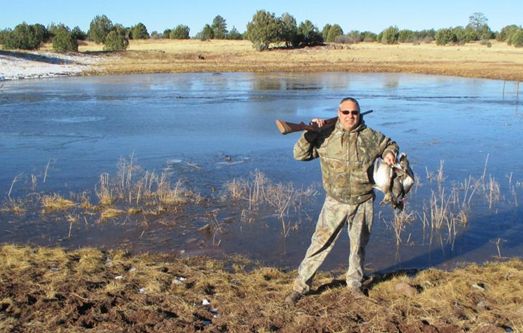
| Articles | Documents | Equipment | Events | Links | Membership | Miscellaneous | Scrapbook | Targets | What's New |
| Ducks Up North | January 2014 | |||
| Gerhard Schroeder
| ||||
|
Sometimes things work out too well. According to the weather reports for Payson
the waterholes around there should not have been frozen shut. Ron and I gambled,
headed north the day after Christmas in pursuit of ducks.
The first waterhole we checked was mostly covered with ice and void of any
feathered beast. Plus the cold wind made me thank myself for wearing many layers
of clothes, including long johns.
Hole #2 allowed us a view from about a half mile away. And at least 4 birds were
on it! We got our guns ready, fetched a telescopic fishing rod with top-water
lure, and made our approach in a wide circle to get at them from behind the berm.
Then we jumped them and fired. With his pump and my over/under empty, all four
ducks were down! One required a finishing shot. Only then did we realize that
all four were still on the open water, and all around this waterhole was a layer
of ice, about a quarter inch thick. But we came prepared, with that fishing rod,
remember?
Well, cast #1 went perfectly, with the lure on retrieve aiming right for the
closest duck. But the lure bumped the edge of the ice and hopped over that duck.
Try again – same thing happened. On cast number three I reeled slower, and the
lure snagged the ice and the line broke. The wind quickly drifted that lure to
deeper waters. Game over.
Now what? It looked like we might get at the closest duck with a big (as in long)
stick. Off we went looking for one. No, there was nothing long enough. Or
rather, that duck was just a little too far from the bank.
Oh, why didn’t I bring my waders!? So what if they are old and one boot leaks a
little. Time for drastic measures, if we wanted the ducks. We wanted! I had
brought rubber boots. They could serve as a second dry set of footwear. So then,
off came the hiking boots, socks, pants and long johns. In my underwear and
wearing just the hiking boots I broke the ice and with plenty of quivering and
quiet cussing entered the icy mucky waters. It got deep way quicker than I wanted.
The water was numbing cold. But with a branch, longest we could find, I fished
out duck number one. I don’t know what was worse, the icy water or the darn wind
once my wet suspension came back out.
Ron had driven that day. He moved his truck close by, with engine idling and the
heater at full blast. Two shop rags served as towels. I hopped back into the
cab until I got at least some feeling back into my lower legs and feet.
Then I attempted duck number two. OK, to make it short, I drew a line, I did NOT
submerge the very sensitive body parts. That did not get me close enough to #2, and
for sure not to numbers 3 and 4. In fact, I crawled back into the cab again,
unthawed, and re-dressed.
. . . three ducks to go
And we swore to ourselves that we’d learned a lesson, from now on to let them
fly past the water’s edge before pulling the trigger. There were 4 additional
waterholes we visited that day. Things did not go perfect when we did encounter
more ducks. But we managed to bag three mallards as well, and none were lost or
required severe measures of retrieval. We even returned to that fateful hole
later in the day. No ducks died. However, I was able to retrieve my lure, since
the wind had moved it closer to the opposite bank. Encouraged by those seven
ducks and the lessons learned we planned our next trip the coming Monday.
That day we really were prepared! Along came my waders, a 12-foot telescopic
fishing rod, extra lures and hooks, a home-made lure that would not snag on the
ice, and sections of aluminum tubing which could function as 15 foot extensions
to attach to the fishing rod. It had frozen more, but there was little wind.
The very first hole we visited had been completely open four days prior. Now
there was only a little section in its middle free of ice, but with several
Scaup on it. Distance from the berm to the open water was substantial. We
only winged one bird. It dove under the ice upon my follow-up shot, never to
be seen again. We used rocks to bust the ice near where the bird had disappeared.
It did not float back up.
To make it short, we checked quite a few water holes. Most were completely
frozen over. By noon we had only seen ducks on a new (to us) hole. A wrong
approach spooked the five mallards before we were in range. So off to the next
pond for a new try, that was our routine. When we topped the berm of the last
hole for that day, things changed.
One mallard drake sat on the edge of the ice, within fine shotgun distance.
Unfortunately Ron and I both fired at that one, dropping it like a rock. Next
we emptied our guns on the next drake, dropping him also. That’s when some
twenty birds lifted off. All escaped unmolested by steel pellets! We could
not reload in time. Except one duck came over seconds later, apparently for
another look at all the disturbance. Ron nailed that one, dropping it nicely
on land.
Ron with four Gadwall, finally
Now the only option was the fishing rod with topwater lure. Whenever that lure
got stuck on the edge of the ice, Ron threw rocks and freed it. Over an hour
after killing the ducks did we finally hook the first one, and slowly dragged
it closer. At least the sun had thinned the ice, and larger rocks (always a
good supply of those around anywhere in Arizona) would bust up a decent path.
By the time we got the last duck off that pond, a good two hours had again been
burnt. It was basically time to head home. As Ron put it: 28 man-hours, a
tank of gas, and a three-duck yield. Good thing we still have our day jobs.
But great memories will stay with us, and hopefully experience gained to hunt
more efficiently next time.
“Time” is the critical factor! Ducks are there, in the Arizona higher country.
But one needs to monitor the weather, and hunt them before too much ice forms.
Unless you have a dry suit.
| ||||
| If you enjoyed this story, or found it useful, please consider clicking here to join the NRA at a discount of $15 off the normal membership cost. You will be supporting both this website and adding your voice in support of the Second Amendment. Thank you very much. |

|

|
|


